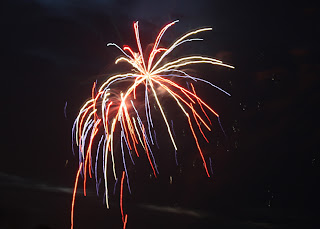So here are some steps for getting the best fireworks pictures you can get...
Physical Set-up:
1.) Use a tripod. I'll talk about the specific shutter times in a bit, but the short version is, you'll mostly want to let them go for about 8 or 10 seconds each.
Last year when I went to the fireworks, I forgot the foot to my tripod, so I was trying to balance the unsecured camera on the tripod body. It was better than *nothing*, but it wasn't good.
Because I knew I would have stability problems, I ended up shooting a lot of 3.2 second shots in the hopes that I could be still that long, but it makes the fireworks look pretty anemic. And there's still a lot of wiggle in the shot. So absolutely have a tripod, even if it's a point-and-shoot camera you're using. Some P-a-Ss have a fireworks setting and one of the things it's doing on that setting is running a longer than normal shutter. So get the camera somewhere stable.
2.) Use a cable release, a remote control or the timer to activate the shutter.
For being hand-held and short shuttered (for fireworks), this shot could have been pretty decent if I didn't have that little wiggle that happened right at the beginning of the shot. See where the blue arrows are pointing? That's where the firework trails were starting when the shutter opened. Odds are good the little wiggles right there are from nothing more than the action of me pressing the shutter button. If you don't have a cable release or remote, you can do what I do - use a two-second timer. It's a little harder to get that sudden "oh that looks cool!" shot, because you need a little lead time. But the results are so much cleaner.
 Here's a shot done on a tripod, with a timer-released shutter:
Here's a shot done on a tripod, with a timer-released shutter: Because the camera was on the tripod I could run a 13 second shutter which gives that great depth of field with so much going on in the shot.
3.) Give some context. If you can, if there's something interesting on the ground below the fireworks, try to include that in the shot. A skyline, a treeline, some boats...
So while this is a nice shot of the finale...
The shot becomes more interesting when you see Navy Pier below it. It gives the fireworks scale and it adds and element of "I was in this particular place for this" to your pictures.
Camera Settings:
Shutter speed: You'll want to experiment with this as you go, but if there's not a lot of background light noise in your area, 8 to 10 seconds tends to give you nice shots with long trails and several shells in a shot.
 When I forgot my tripod, I was only running roughly 3-second shutters. Which can leave the shots looking kind of thin and uninteresting.
When I forgot my tripod, I was only running roughly 3-second shutters. Which can leave the shots looking kind of thin and uninteresting.Here's a shot done a 2.5 seconds - which is ridiculously long for anything shot in the daylight, or even indoor lighting, but for fireworks, it's pretty short.
Here's a similar shot at 6 seconds. Just by doubling the time you can see how much more happens in the picture.
When you get up to 10 seconds, you get an even more full picture.
 On the flipside, you can leave the shutter open *too* long. Twenty seconds, especially during the finale, can let in too much light, and the fireworks just pile up on top of each other.
On the flipside, you can leave the shutter open *too* long. Twenty seconds, especially during the finale, can let in too much light, and the fireworks just pile up on top of each other.ISO and F-stop:
Both ISO and F-stop determine how much light is hitting the camera sensor at any given time. The shutter determines how long light is hitting the shutter.
Obviously when you're taking pictures of light, you don't want to narrow down your aperture so much that light can't get in reasonably quickly. I shot most of these better shots at F-11. It let the firework light in, but blocked out most of the streetlamp noise.
Using a very wide aperture lets in light you may not want - like if there's just a bit of daylight still behind the fireworks. Then you get a shot like this:
You can see the clouds behind the fireworks because the shutter was open so long, the moonlight was actually making it through even though we really couldn't *see* that it wasn't pitch black there. This was done at F-4.5, as low as my camera will go.
A lower ISO keeps the trails nice clean and the black of night a nice solid black sheet. As with any shooting, a higher ISO makes for grainy pictures, which can be particularly noticeable on the black sky.
So when you add all these tips up, you can get some really fun fireworks shots.
And of course, Happy 4th of July to everyone for whom it is relevant!













